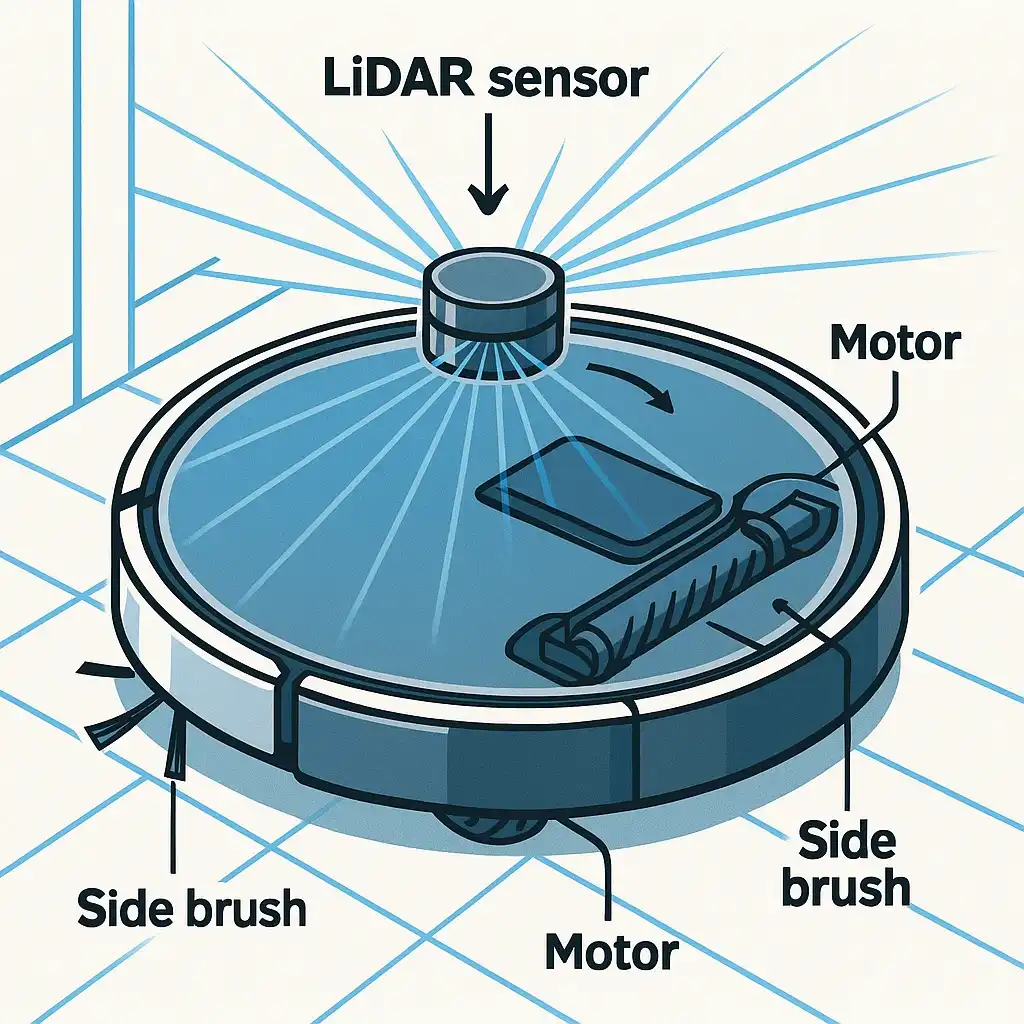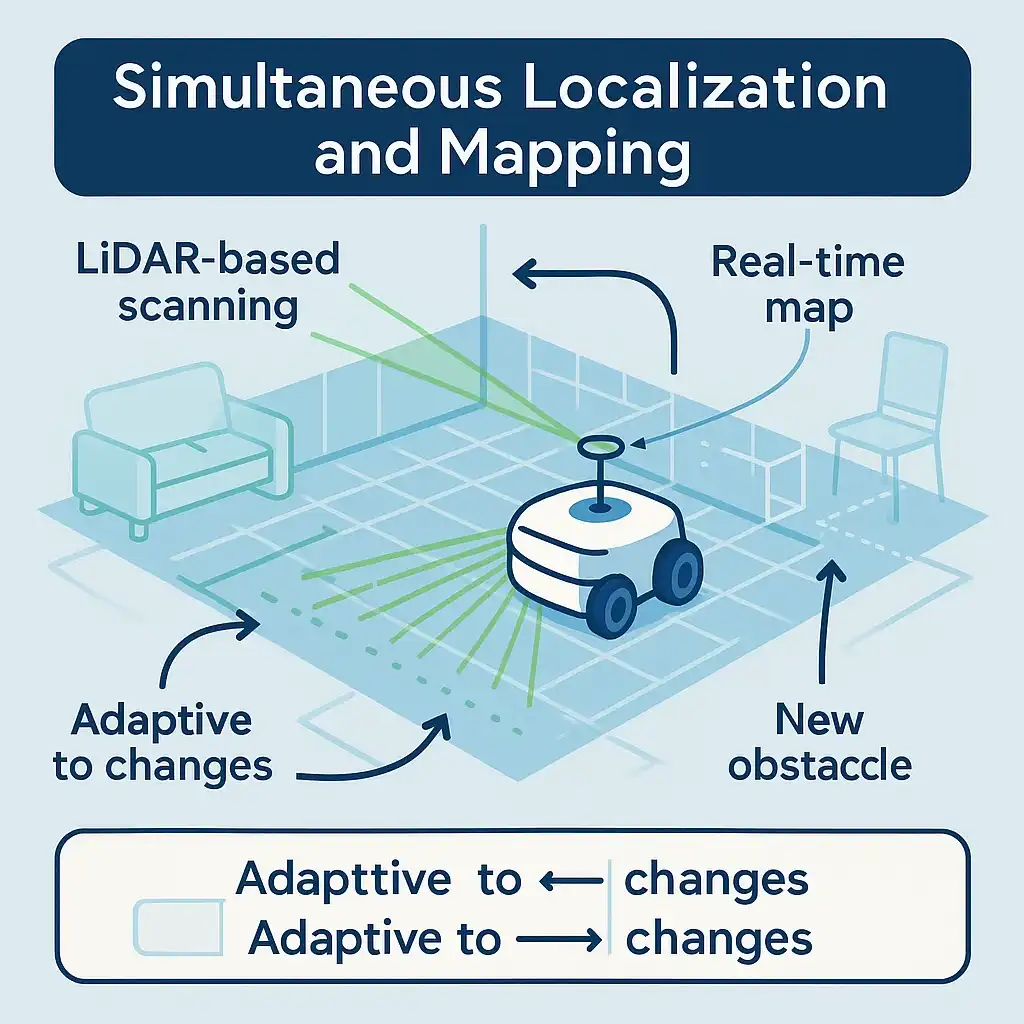Smart navigation technology has transformed robot vacuums from random wanderers into intelligent cleaning partners. The secret? Mapping systems that digitally chart your home layout with incredible precision. Modern vacuums use a combination of advanced sensors, sophisticated algorithms, and real-time artificial intelligence to understand exactly where they are and where they need to go.
Instead of bouncing randomly from wall to wall, today's smart cleaners create detailed robot maps of your floors. They plan optimal cleaning routes based on room layouts and obstacle locations. They learn your home's layout with each cleaning session, becoming more efficient over time.
This transformation matters because it directly impacts cleaning effectiveness. A cleaner that understands your home's layout finishes its work faster, covers every corner thoroughly, and avoids getting stuck or lost. Whether you live in a compact apartment or a sprawling multi-level house, understanding how mapping technology works helps you choose the right solution for your specific needs.
Why Mapping Technology Changed the Game
Gone are the days of random movement. With built-in navigation systems, modern cleaning devices now scan your floors and create detailed maps of your home. These maps help them:
- Cover every inch in logical, overlapping rows
- Avoid knocking over items like vases or pet dishes
- Remember furniture layouts for future cleaning
- Recharge and resume without repeating areas
The result? Cleaner floors, fewer collisions, longer battery life, and less supervision needed.
From Chaos to Coordination
Random Cleaning vs. Smart Mapping: Early robot vacuum models operated purely on chance. They relied exclusively on simple bump sensors that detected obstacles only through collision. When they encountered a wall or furniture, they would randomly select a new direction and continue moving. This approach left many areas uncleaned while others received multiple passes.
The cleaning efficiency was poor. Early models could take 2-3 hours to clean a space that modern vacuums complete in 30-45 minutes. They frequently got stuck in corners, tangled in cables, and left systematic coverage gaps.
In stark contrast, modern vacuums with mapping technology operate strategically. They divide your home into distinct zones and rooms. Each zone receives methodical, overlapping coverage patterns. The vacuum creates organized cleaning routes that minimize backtracking and wasted motion. Once an area is cleaned, the robot remembers that location and focuses on uncleaned regions.
This difference is transformative. A home that once required occasional manual intervention can now run daily cleaning cycles with complete autonomy. The robot knows precisely where it has been and where it needs to go. Modern navigation is no longer a luxury feature-it's the foundation of practical, reliable robot vacuum use.
How the Technology Works: Understanding Robot Vacuum Navigation Systems
To understand how robot vacuum mapping works, we need to examine the complete process from sensor data collection through map creation and route planning.
The Basic Mapping Process
When a robot vacuum starts its first cleaning session, here's what happens behind the scenes:
Environmental Scanning: The vacuum's sensors continuously gather information about its surroundings. Infrared signals bounce off walls and obstacles, returning detailed distance measurements. Cameras capture visual data identifying landmarks like doorways and furniture edges.
Data Processing: Advanced algorithms analyze sensor data in real-time. The vacuum calculates its exact position relative to walls and obstacles. It builds a coordinate system that places every scanned point in space.
Map Creation: As the vacuum moves through each room, it adds new spatial information to its growing digital representation. The result is a detailed robot map showing wall positions, doorways, obstacles, and open spaces.
Route Planning: Using this map, the vacuum calculates optimal cleaning routes. It determines how to cover every area efficiently without backtracking excessively.
Continuous Refinement: With each cleaning session, the map becomes more accurate. The vacuum detects moved furniture, new obstacles, or blocked pathways and updates its understanding accordingly.
This entire process happens continuously while your vacuum cleans. Modern processors enable real-time map updates and route adjustments, allowing the robot to respond instantly to unexpected obstacles or changes in your home layout.
The Sensor Arsenal

- LiDAR – A spinning laser sends thousands of pulses per second. It creates a 360° scan, even in total darkness.
- Visual Cameras – Front lenses capture images. They enable Visual SLAM mapping using landmarks like doorframes or lamps.
- Infrared Sensors – Detect ledges or stairs, preventing falls by spotting changes in floor height.
- Ultrasonic Sensors – Found in some high-end models, they sense soft objects (like curtains) more precisely.
- Bumper Sensors – If all else fails, these physical triggers detect contact and prompt rerouting.
Together, these tools feed data into the robot’s brain, helping it navigate safely and smartly.
Understanding Cleaning Routes and Path Optimization
One of the most important advantages of mapping technology is intelligent route planning. A mapped cleaning route is fundamentally different from random movement patterns.
How Cleaning Routes Work
When your vacuum creates a robot map of your home, it uses that map to determine the most efficient cleaning routes. Rather than wandering randomly, the vacuum follows a logical sequence:
- Wall Following: The vacuum starts by tracing walls. This creates defined boundaries for each room.
- Grid Coverage: The vacuum then implements a systematic grid pattern. It travels in parallel lines that overlap slightly, ensuring complete coverage.
- Targeted Zones: High-traffic areas or rooms with more debris can be prioritized for additional passes.
- Obstacle Avoidance: Detected obstacles cause the vacuum to recalculate its path while maintaining overall room coverage.
This intelligent approach dramatically reduces wasted motion. Instead of traveling 500 meters to clean a 200 square meter apartment, a mapped vacuum might achieve the same coverage in 300 meters.
Real-World Impact of Optimized Cleaning Routes
These optimized cleaning routes translate directly to practical benefits:
- Shorter Cleaning Times: A room that took 90 minutes with random navigation takes 40 minutes with mapped navigation.
- Extended Battery Life: Less wasted movement means the battery charge lasts longer, enabling larger homes to be cleaned on a single charge.
- Better Coverage: The systematic approach ensures virtually complete floor coverage with minimal repeats.
- Reduced Wear: Less movement means less mechanical stress on motors and wheels, extending robot lifespan.
Core Mapping Capabilities
Modern cleaners use advanced technology to generate detailed plans of your home. Using sensors like LiDAR and infrared, they can build either simple 2D layouts or sophisticated 3D representations. Once created and saved, the device uses these maps to follow intelligent paths and ensure thorough corner-to-corner cleaning.
The mapping process works in connected layers. First, the cleaner scans individual rooms using continuous sensor data. Second, it builds a coordinate-based spatial layout from that data. Third, it plans optimized routes that adapt in real-time to obstacles or layout changes. This layered approach enables efficient navigation even in complex spaces with tight passages and moving obstacles.
Devices using these mapping systems become significantly more efficient than non-mapping models. They understand precisely where they are in your home. This location awareness drives continuous optimization. Your home environment stays cleaner while the robot uses less energy. Whether reaching corners or avoiding obstacles, intelligent route planning through detailed mapping is the key differentiator.
Mapping Software and Intelligence

What is SLAM? Simultaneous Localization and Mapping (SLAM) lets a robot build a map while tracking its exact position. SLAM systems use LiDAR or other spatial data to create real-time layouts. They adjust when furniture moves or new obstacles appear. SLAM is fast, reliable, and works well in low light.
What is Visual SLAM? Visual SLAM uses camera images instead of lasers. It compares video frames to find patterns and landmarks. This updates the vacuum's location as it moves. Visual SLAM works best in well-lit homes and visually rich spaces.
Hybrid Mapping Systems: Some of the smartest vacuums from brands like Roborock and Ecovacs Robotics combine SLAM and Visual SLAM. These hybrid systems use LiDAR for precision and cameras for context. This allows smarter obstacle recognition and faster map updates.
Smart Features Built on Mapping
Intelligent Room Division: Once a map is made, the robot can identify and label rooms. Through your app, you can assign tasks like "Clean the kitchen after dinner" or "Avoid the nursery until 10 AM."
No-Go Zones: Mapping lets you draw digital No-Go Zones. Just tap your phone screen to block areas with pet bowls, toys, or delicate rugs. No physical tape needed.
Multi-Floor Support: Some advanced vacuums memorize multiple floor layouts. Carry the robot upstairs, and it switches to the second-floor map instantly. This is great for townhouses and split-level homes.
Real-Time Object Avoidance: Newer models recognize items like shoes, charging cables, and pet messes. They avoid these in real time using AI object detection. This reduces cleanup stress for homeowners.
Real-Life Benefits of Mapping in Daily Cleaning
When a mapping-equipped cleaner moves through your home, it operates methodically and adapts to your habits. Thanks to LiDAR scanning, the device updates cleaning paths in real time. It can also update its map as furniture or clutter moves. This maintains efficiency over time.
Optimizing Every Cleaning Session
Each session gets better as the vacuum gathers more data. It uses mapping to identify areas needing more attention. It adjusts suction power based on floor type or dirt level. This makes mapping-equipped devices ideal for homes with pets or heavy foot traffic.
Is Privacy a Concern?
Absolutely. Robot vacuums collect sensitive spatial data, and some use cameras. Look for privacy features like:
- On-device processing (no cloud upload)
- Encrypted maps
- Local-only mode to turn off cameras
- Regular firmware updates from trusted brands like iRobot and Samsung
Feature Comparison: Which Tech Fits Your Home?
| Mapping Method | Best For | Strength | Weakness |
|---|---|---|---|
| LiDAR | Large, complex layouts | Works in any light | Slightly taller robot |
| Visual SLAM | Bright, detailed spaces | Uses real-world landmarks | Struggles in darkness |
| Hybrid | Mixed environments | Most accurate overall | Higher price point |
Top Models Comparison: Best Mapping Options in 2025
Choosing the best mapping-equipped cleaner depends on your space and budget. Some models shine in large homes, while others are perfect for small apartments.
- Roborock S8 MaxV Ultra – Often rated top-tier for large, multi-level homes. It uses pinpoint LiDAR and dual AI cameras.
- iRobot Roomba j7+ – Excels at obstacle avoidance with smart mapping that improves after every run.
- Samsung Powerbot Jet – Shows enhanced accuracy after recent firmware updates.
- Ecovacs Deebot T30 Omni – A hybrid vacuum-mop pairing precise LiDAR with multi-floor map storage.
Mapped Navigation vs Random Movement: Which Works Better? Early models used random bump navigation. They needed more passes and still missed debris. In contrast, mapping-equipped devices finish faster. They chart efficient paths, remember cleaned zones, and re-dock for quick top-ups instead of quitting early. In real tests, mapped navigation outperforms random cleaning in coverage and battery efficiency.
Understanding Floor Mapping Technology: Still curious about how floor mapping works? It's the digital layout the device builds and saves. This map tells the cleaner where it has been and where to go next. This ensures even, streak-free coverage without overlap.
Choosing the Right System: Buyer's Guide 2025
When selecting a mapping-equipped cleaner, understanding the pros and cons of each technology is essential. LiDAR-based models excel in large, complex homes. They create precise 360° scans that work in any lighting condition, making them reliable day or night. However, LiDAR systems often come with a higher price point. Visual SLAM, on the other hand, uses cameras to recognize landmarks and works great in bright, visually rich spaces. It's usually found in more compact models but can struggle in low-light conditions. Hybrid systems combine the strengths of both LiDAR and Visual SLAM, providing highly accurate maps and faster updates, though these tend to be the most expensive options.
Popular models offer different strengths to match your needs. The iRobot Roomba j7+ leads in obstacle avoidance and smart mapping, ideal for homes with pets and clutter. Roborock's S8 MaxV Ultra delivers top-tier LiDAR and AI cameras, perfect for large, multi-floor homes. Ecovacs Deebot T30 Omni uses a hybrid system combining LiDAR and camera data, great for users wanting mop and vacuum functions together. Samsung's Powerbot Jet has improved accuracy with recent software updates and works well in complex layouts. Shark and Eufy also offer budget-friendly options with solid features, making advanced technology accessible to more households.
Here are some quick recommendations to help you decide:
- Best for apartments: Eufy RoboVac models with Visual SLAM offer compact design and efficient navigation for smaller spaces.
- Best for large multi-floor homes: Roborock S8 MaxV Ultra with LiDAR and multi-floor mapping support.
- Best budget-friendly option: Shark AI Robot vacuums combine solid mapping with affordable pricing.
- Best for pet owners: iRobot Roomba models excel at obstacle avoidance and pet hair pickup with smart mapping.
Choosing the right mapping-equipped device depends on your home size, budget, and cleaning needs. Investing in a model with reliable mapping technology ensures efficient, thorough cleaning every time.
FAQ: Understanding Mapping Technology
Q: How does mapping technology work? A: The system uses sensors like LiDAR or cameras to scan your home's layout. The device builds a digital floor plan that guides its cleaning path efficiently.
Q: How do cleaners map your house? A: They collect spatial data through lasers or visual cues and process it to create a detailed layout. This map helps track cleaned areas and guide future navigation.
Q: What is a digital floor plan in cleaners? A: A digital layout is created by the device to navigate your home. It stores room layouts, obstacles, and zones for optimized cleaning and efficient operation.
Q: Can devices update their maps in real time? A: Yes, most modern models update their maps in real time to adapt to furniture changes or new obstacles, improving accuracy over time.
Q: Do all cleaning devices have this technology? A: No, only models labeled as mapping-equipped use sensors and software to create and utilize digital layouts. Others rely on random or basic navigation patterns.
Q: Is mapping technology safe for privacy? A: Most brands use on-device processing and encrypted maps to protect your data. Some allow disabling cameras or cloud syncing for extra security.
Q: How often does a device need to remap? A: Typically, the device updates its map during each cleaning session, especially if it detects changes in the environment or layout.
Final Thoughts
Mapping technology is no longer a luxury-it's essential for any smart home. Paired with features like auto-empty stations and mop pads, it makes cleaning faster and easier. Whether you want more control or hands-free operation, investing in a mapping-equipped device pays off daily. From small apartments to complex multi-level homes, this technology ensures every inch gets the attention it deserves.
As you explore your options, understanding the future of smart home cleaning with AI-driven advancements can inform your purchasing decision. Modern navigation systems are just one piece of the intelligent cleaning revolution that continues to shape how we maintain our homes.
